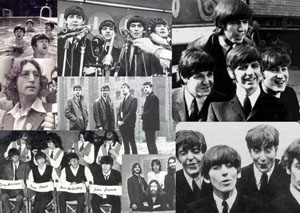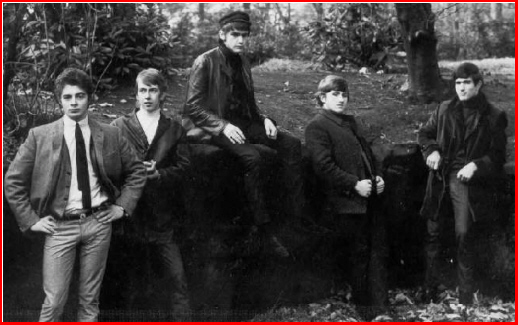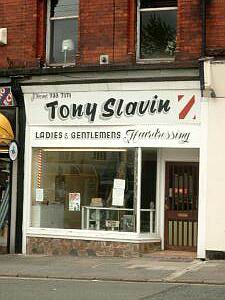|
The Beatles' Hair Dresser: Bioletti
The Beatles from Liverpool
England had an Italian Hair Dresser. The famous opening lyrics of
the Beatles’ ‘
Penny Lane
’ released as a single 17 February 1967: ‘In
Penny Lane
there is a barber showing photographs / Of every head he’s had the
pleasure to know. / And all the people that come and go / Stop and say
“Hello.”’ We welcome this informative article by author
Christopher T. George.
The
Bioletti Family of
Liverpool
: From the Maybrick Case to John Lennon and the Beatles
By Christopher T. George
What connects the Maybrick case of 1889 with the Beatles? It is a bit of
a long and winding road, so read on. . . .
‘You Might Well Arsk,’ to quote the title of one of the short,
humorous pieces that Beatle John Lennon published in his Edward
Lear-like nonsense collection In His Own Write, for which the
Liverpool pop musician won Foyle’s Literary Prize, 23 March 1964. At
the Foyle’s Luncheon held in his honor, John’s entire acceptance
speech was, ‘Thank you very much. You’ve got a lucky face,’ before
he made a hasty exit.
Ah, the heady year of 1964, almost four decades ago—the year that the
Beatles first made it big in the United States on the Ed Sullivan Show
(in February) and came home to Liverpool to a tumultuous Beatlemania-style
civic reception on 10 July at the city’s 18th Century Town Hall in
Castle Street, the same day they attended the premier of their movie
‘A Hard Day’s Night’ at the city’s Odeon Cinema, London Road.
Lennon’s In His Own Write contained a number of satirical and
irreverent pieces about ‘Liddypool’ as Lennon described his native
city, the site of this year’s Jack the Ripper convention [August
2003]. If the Lord Mayor had read them closely perhaps he wouldn’t
have given the lad and his mates a civic reception.
‘There are places I remember. . .’
A Lennon and McCartney song that was to appear on the group’s
‘Rubber Soul’ album released the following year, on 3 December 1965,
as originally conceived by John, contained a number of references to
places he remembered from his childhood growing up in the southern
suburbs of Liverpool. Among the locations mentioned were the tram sheds
(streetcar warehouse to our American friends) in Smithdown Road and a
certain barber’s shop to the east at the road junction with a bus
shelter in a roundabout in the center of the junction known locally as
‘Penny Lane’ from a street that runs into the intersection. Both
places were close to John’s first boyhood home of
9 Newcastle Road
, located north of the bus shelter. If you know ‘In My Life’ you
will be aware that those geographical references were all removed in the
final version of the song which speaks in more general terms about the
past and loves won and lost. The barber shop though, is famously part of
the opening lyrics of the Beatles’ ‘
Penny Lane
’ released as a single 17 February 1967: ‘In
Penny Lane
there is a barber showing photographs / Of every head he’s had the
pleasure to know. / And all the people that come and go / Stop and say
“Hello.”’
During John Lennon’s boyhood, during the 1950’s, the barber was Mr.
Bioletti, although the shop in more recent decades has changed hands and
was sold by the family. And here is where the connection with the
Maybricks comes in—in August 1889, James A. Bioletti, stated to then
have been a hairdresser and perfumer of
Dale Street
, testified at the trial of Florence Maybrick about the use of arsenic
as a depilatory. The hairdresser’s testimony was part of an attempt by
Florie’s counsel, Sir Charles Russell, to establish that Florie really
did soak the flypapers to make an arsenic-based cosmetic, not to bump
off husband James, as the prosecution alleged. Bioletti was part of a
parade of witnesses who appeared at the trial in St. George’s Hall,
Liverpool
, before Justice Sir James Fitzjames Stephen.
The
Trial of Mrs. Florence Maybrick
James Bioletti (examined by Sir Charles Russell): I am a
hairdresser and perfumer, carrying on business on
Dale Street
,
Liverpool
. I have been in business for about thirty years. Arsenic is used a good
deal in the hair for some purposes, and I have used it as a wash for the
face on being asked for it by ladies. There is an impression among
ladies that it is good for the complexion. I have used it on a few
occasions, and only when I have been asked for it.
Sir Charles Russell: Was Mrs. Maybrick ever a customer of yours?
Mr. Bioletti: Not to my knowledge.
Mr. Addison (cross-examining): You say that you use it for the
hair. Tell me how you use it?
Mr. Bioletti: Very largely for removing hair. It is used
principally by ladies for removing hair from the arms. I mix it with
lime—one-quarter of arsenic to three-quarters of lime, in powder. I
generally use yellow arsenic, but I have used white arsenic. I put the
lime and arsenic up together and label it ‘Depilatory,’ along with
the directions.
Mr. Addison: There is nothing to show that there is arsenic in
it?
Mr. Bioletti: No. I generally put it up in a two-ounce bottle. I
produce one of my bottles. The label is as follows:--’Depilatory, to
remove superfluous hair; mix with a quantity of water to the consistency
of a thick cream, and then spread one-eighth of an inch on skin, and all
over it, to remain three minutes; if the skin is sensitive, five
minutes. Then remove it with a paper knife. Wash with cold water, and
apply a little cold cream. Do not touch a sore or it will be painful.’
I have never tasted it, and I cannot say whether the lime would make the
yellow arsenic very nasty to the taste.
Mr. Addison: Do you know whether it is used as a cosmetic?
Mr. Bioletti: Not as a rule. I have been asked for it a very few
times in my life. I have been spoken to on the subject by ladies, asking
as to its value as a cosmetic. It is supposed to be a good thing for
improving the complexion. I only prepared it just for the occasion, and
only in small quantity. I only remember distinctly one occasion.
Sir Charles Russell (re-examining): The depilatory is in common
use.
Sir Charles Russell: Although you do not have it for sale, are
you sometimes asked for it for the purpose of cosmetics?
Mr. Bioletti: Yes.
Sir Charles Russell: In that case you would prepared it in that
form, I suppose, in solution?
Mr. Bioletti: I would just put a little into milk of almonds. I
have seen it in the country papers recommended for making the hair grow.
Was Bioletti a Fighter with Garibaldi?
John Lennon and his boyhood friends thought that the old barber they
knew in the 1950’s (John was born in 1940) was an immigrant from
Italy
, though my research shows otherwise. The Biolettis had actually been in
Britain
since the early decades of the 19th century, and were descendents of
Alberto Bioletti, born about 1778 in
Turin
,
Italy
, who married an Englishwoman, Mary Feltham. Possibly Alberto Bioletti
was a emigré who had left
Italy
because of the turmoil of the Napoleonic Wars.
According to a story on an Irish website written by Lennon’s friend
David Ashton, the old barber that the schoolfriends knew in the 1950’s
had military memorabilia in his shop and gave the impression he could
have fought with the Italian freedom fighter, Garibaldi. A stretch,
though! The then barber would have had to have been over a century old
if he fought with Garibaldi in 1860—as Ripper suspect Roslyn
D’Onston is known to have done—to enable him to be still alive when
Lennon and his mates frequented the shop!
Ashton remembered:
It was rumoured that old man Bioletti had been involved with Guiseppe
Garibaldi (1807-1882) in
Italy
's battle for independence and statehood. The Bioletti family had old
guns, bullets, grenades and pictures of happy Italians waving their
flags high, on the walls around the barber shop.
They were certainly a loving, kind, happy family with brother, sister
and old man Bioletti cutting your hair. Unless you knew him, and I guess
he would have been nearly ninety when I was 9 or 10 years old, old man
Bioletti in 'Penny Lane Barber Shop' would frighten the life out of you
with his shakey hands thinking that any moment he would nip your neck or
cut your ear off. When you knew him he really was a kind, loving, gentle
ex-revolutionary who actually loved us lads and he often with his shaky
hands deviated from the regulation army-pudding-bowl, short
back-and-sides hair cut that our parents demanded—sometimes to good
effect, sometimes to bad effect.
Ashton related a hilarious episode that centered on Mr. Bioletti’s
‘shaky hands’ and that once more illustrates John Lennon’s famous
offbeat if not bizarre sense of humor:
Old man Bioletti also had a rule that boys could only get their hair
cut when there were no men waiting. I had met John going into Bioletti's
in
Penny Lane
on his way back from
Quarry
Bank
School
and me from the
Bluecoat
School
. It was after 4 in the afternoon and not long before the men would
start arriving on their way home from work with their gasmask knapsacks
they used to wear round their necks to carry their packed lunches -
their 'bait' - and newspapers. John and I sat down on Bioletti's
comfortable bus bench seats that the family had for the boys to sit on
and read comics. We were behind two other boys in the queue when some
men came in. Exasperated, John said to the two lads in front of us ‘Do
you know, last week old man Bioletti's cut off somebody's scalp
completely, with his shakey hands. You could actually see the brains
wobbling around like a dark grey blancmange inside the head. But he was
alright 'cos he stuck the scalp back on with sticking plaster’. The
two boys left - without a haircut and we got ours done before the rest
of the men came in. It was this taste for devilment and bizarre imagery
and creative thinking that made John an attractive friend to have on
your side.
The Dorset Connection
As Ripperphiles will know, there are a number of connections of the Jack
the Ripper case with Dorset—specifically that leading Ripper suspect
Montague John Druitt was a Dorset man as was the man in charge of the
case, Chief Inspector Frederick George Abberline of Scotland Yard, and
the last canonical victim, Mary Jane Kelly, was killed in a court off
Dorset Street, Spitalfields.
Well, not that the Biolettis have, to my knowledge, any direct
connection to the Whitechapel murders, except peripherally through Mrs.
Maybrick’s trial, if we grant that James Maybrick has been thrust into
the limelight as a possible Ripper suspect through the famous or
infamous Diary, but it transpires that the family has a Dorset
connection too. James Bioletti who testified at for the defense at
Florie’s was born in Shaftesbury,
Dorset
, according to the 1891 census.
Alberto Bioletti, grandfather of James, the man who was born in Turin
around 1785, married Mary Feltham, born in Crediton, Devon, who gave
birth James Feltham ‘Jacques’ Bioletti (1808-1882) in Crediton.
Jacques married Maria Roberts, born about 1806 in Shaftesbury, and they
gave birth to James Albert Bioletti (ca. 1836-ca 1921) who testified in
the Maybrick case. It must have been ‘Jacques’ Bioletti who placed
in the 9 September 1865 edition of the
Liverpool
newspaper The Star a small front page advertisement reading, ‘Now
Open. Bioletti’s New Hair-Dressing Rooms. The Largest Appointed in
Liverpool
. 31 Bold Street.’ Evidently the Biolettis moved later to
Dale Street
, or else possibly for a time father and son carried on business
separately and simultaneously in those two prosperous
Liverpool
city streets. This should be the subject of further research.
By the time of the 1881 census, James F. ‘Jacques’ Bioletti was
listed in that year before his death as a retired hairdresser, living
with his wife Maria in the household of their son-in-law, Frederick T.
Smith, at 62 Arundel Street, Toxteth Park, Liverpool. The hairdresser
and perfumer who appeared at Florie’s trial, James Bioletti, was then
aged 45, and he and his Shaftesbury-born wife Elizabeth Smith Bioletti,
age 37, lived next door at 64 Arundel Street. Interestingly, in the 1881
census it is beside
Elizabeth
’s name not James’s, as might be expected, that under
‘occupation’ it states ‘haircutter employing 3 men.’ The couple
had six children, ranging from 15-year-old Eliza to two-year-old Cora.
All of the children, except the infant Cora, including three boys,
Theodore, Leslie, and Kesari, are listed as ‘scholars.’
By the time of the 1891 census, the family of James and Elizabeth
Bioletti were living at
144 Granby Street
,
Toxteth
Park
. The couple’s first son was listed as a dentist, the younger brother
Kesari was an upholsterer, and the second son, Leslie Bioletti, was
shown as a hairdresser born circa 1871 presumably assisting his father
whose occupation was given as a hairdresser, now age 55, with his wife
Elizabeth aged 47. Thus, it may have been Leslie, then aged 20, who was
the elderly barber with the ‘shaky hands’ and the alleged
‘Garibaldi revolutionary’ that Lennon and his friends knew if he was
still alive when they were boys following the Second World War. My
cousin, Kenneth W. Matchett, who lived in Penny Lane in the decade prior
to the war in St. Barnabas cottage with his father, Liverpool music hall
comedian Billy Matchett (my Grandad’s brother), recalls buying a car
from young Harry Bioletti, presumably James Bioletti’s grandson, for
£5.0.0! Ah, the good old days! The car, Ken reports, was a 1929 Gordon
England
fabric covered Austin Seven two-door saloon with sunshine roof, 6 inches
square!
Roger
Bioletti Adds to the Mersey Beat
Interestingly, following in the Beatles’ footsteps, one of the
Biolettis was involved in the pop music business in the mid-1960’s,
adding to the Mersey Beat that produced some 300 pop groups following
the national and international success of Liverpool groups such as the
Beatles, Gerry and the Pacemakers, and the Searchers. Specifically, in
1965, Roger Bioletti, nephew of the barber and son of a head librarian
at the
Picton Road
, Wavertree, branch of the Liverpool City Libraries, became the drummer
for the second line up of the Georgians rhythm and blues band. Roger was
a
Quarry
Bank
High School
schoolboy as were some of the other bandmates, and John Lennon before
them (the Beatles were originally known as the Quarrymen). That’s
Roger in the Lennonesque Greek fisherman’s hat seated looking rather
lost in the group photograph taken in Woolton Woods that year.
As
mentioned earlier, some years ago, the Bioletti barber shop in
Penny Lane
, or more precisely
11 Smithdown Place
,
Liverpool
15, was sold to another hairdresser, Tony Slavin, offering ‘unisex’
hairdos. The look of the original Bioletti barber shop was re-created
for the video of the song ‘Free As a Bird’ on the Beatles Anthology
released in 1995. In recent decades, the bus shelter in the roundabout
that the Beatles sang about in their 1967 hit ‘Penny
Lane’—‘there beneath the blue surburban skies’—has been
converted into a café called ‘Dr. Pepper’s.’
.jpg)
|
| Christopher
T. George was born in Liverpool, England in 1948 and
first emigrated to the United States with his parents in
1955. He went back to Liverpool for a refresher on his Scouse
accent, living with his grandparents while attending Rose Lane and
Quarry Bank Schools. Chris returned to the U.S.A. in 1968 and has lived
there ever since. He now lives in Baltimore, Maryland, near Johns
Hopkins University with his wife Donna and two cats.
|

|




.jpg)
